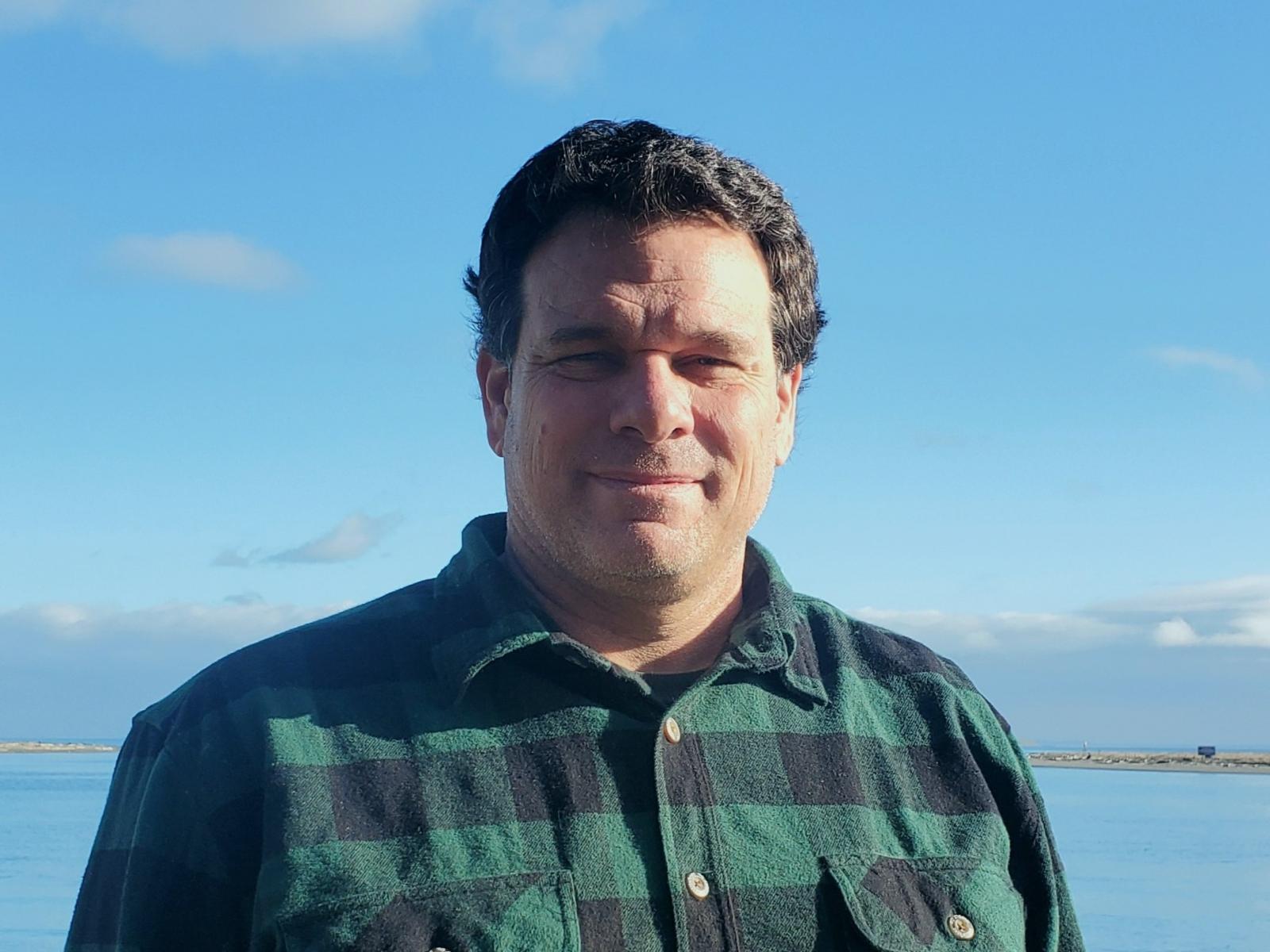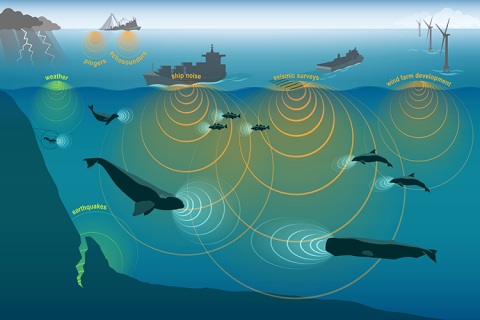Creating Ears Under Water: Researching the Effects of Underwater Noise with Joe Haxel

Many marine wildlife species, including mammals, fish, and invertebrates, use sound or acoustic signals in the ocean for a variety of life functions, such as communication, foraging, navigation, and reproduction. Maintaining healthy coastal ecosystems includes protecting the acoustic environment for these marine species. Since many marine animals are responsive to noise in their environment, they can be greatly impacted by disruptions or changes to the soundscape they are accustomed to living in.
Marine energy is a form of renewable energy technology that uses devices like wave energy converters and tidal turbines to convert energy from tides, waves, and ocean currents into electricity. As it develops, the marine energy industry is focused on understanding its impacts to the environment, including contributions to underwater noise levels. Before marine energy devices are able to provide clean renewable energy for humans, it is imperative to understand how noise generated by these devices affects soundscapes under water. Efforts to research the frequencies and levels of sound made by marine energy devices, including determining if these anthropogenic signals overlap with frequencies used by wildlife species, will provide valuable information to regulators who permit the use of marine energy devices. The duration or exposure of marine energy-associated sound levels and how they impact behavior of underwater inhabitants are all under evaluation to understand potential consequences to marine animals.
The Triton Initiative, a U.S. Department of Energy Water Power Technologies Office project, focuses on researching the potential environmental effects of marine energy devices to support the permitting of marine energy deployments. Through partnerships and collaborations with universities, industry, and regulators, Triton focuses on technological solutions to address these challenges. marine energy is one of the many energy solutions needed to help build healthy communities and minimize carbon emissions in the United States. Triton’s work helps to make sure marine energy emerges as a cost-effective, sustainable, and low environmental impact sector. The Triton Field Trials (TFiT) is an effort where field trials explore methods and test technologies and instrumentation used to study specific stressors of marine energy systems. TFiT is developing recommendations for methods and instrumentation to monitor these topics. The four main stressors associated with marine energy as identified in the “2020 OES-Environmental State of the Science Report” include changes in habitat, electromagnetic fields, collision risk, and underwater noise. Marine scientist and principal investigator for Triton, Joe Haxel, leads the underwater noise stressor research for TFiT.
Haxel’s career in marine science started at Oregon State University (OSU) where he conducted graduate research on nearshore processes, including sand bar dynamics, ocean currents, and the formation of beaches. This experience led him to a 19-year career at OSU's Hatfield Marine Science Center in Newport, Oregon. There, he worked in a cooperative institute affiliated with the National Oceanic and Atmospheric Administration’s Pacific Marine Environmental Laboratory's Acoustic Program using underwater acoustics to study a wide range of marine geophysical processes, including seafloor earthquakes, volcanic systems, and ice sheet dynamics in Antarctica. Much of this time was spent at sea, deploying and recovering moorings and equipment, traveling around the world to conduct research in every ocean, and soaking up as much knowledge about hardware and underwater technologies as possible. Eventually, as a PhD student, he joined a project at OSU supporting a new effort for marine energy in the wave environment near Newport, OR, known as Northwest National Marine Renewable Energy Center. His role at the Northwest National Marine Renewable Energy Center was to address environmental concerns about underwater noise produced during wave energy converter testing. This job marked the beginning of his research interests in marine energy related to underwater noise and grew into a role at the PacWave marine energy test site, where he led acoustic monitoring research. In early 2019, he was invited by Triton to participate in TFiT deployments at the Pacific Northwest National Laboratory Marine and Coastal Research Laboratory, where he eventually transitioned to the Triton team in June of 2020 as Triton's principal investigator and lead for acoustic research.
Using sound to navigate

A visualization of noise sources and how they travel through the marine environment.
Credit: NOAA NEFSC Passive Acoustic Research Group Triton
Built from decades of experience, Haxel’s deep knowledge of underwater acoustics and his familiarity with marine energy device testing enables him to successfully assess the best technologies and methods for studying underwater noise. This stressor is a concern for regulators who permit the deployment of marine energy devices because signals from marine energy technologies can have significant impacts on the lives of marine animals; this may lead to acute or chronic stress to the animals and cause them to avoid areas within their habitat range. On land, light or optics is the sensory mechanism humans are familiar with—we use it most often for navigating to the grocery store, identifying a mate, or hunting for the perfect house. Humans can see much farther than we can hear or smell. Typically, our eyes provide us with more detail about an object than our ears. Conversely, in the ocean, sound is the sensory modality that is most efficient for navigating daily life decisions and it provides the most detail to the landscape for most underwater species. When compared to light, which moves through the atmosphere to our eyes at a rate of nearly 300,000 kilometers per second, underwater light scatters and attenuates easily. It only significantly penetrates the top surface layer to about 200 meters. While noise travels ~332 meters per second in air, it travels a whopping 1,500 meters per second in water. This speed and distance provide animals the opportunity to use sound production and reception to navigate in their environment. Marine animals have adapted to these physical realities and use acoustics to image (through sonar), navigate, communicate over long distances, avoid predators, and locate food. If we introduce a foreign object that masks these important signals or increases stress to marine animals, it can impact them greatly.
Marine animals have different hearing thresholds and communicate in all frequency ranges. The underwater soundscape can be noisy, much like a rainforest, with many species communicating at once. These natural sounds direct how animals behave. Depending on where or when an marine energy device, ship, or sonar system is introduced, a behavioral response may be evoked, preventing or stopping animals from performing a critical life function—like a sea lion being driven to a less abundant foraging location, or a whale calf being too stressed to nurse its mother. According to the “2020 OES-Environmental State of the Science Report”, the underwater noise emitted from marine energy devices in operation is not likely to be harmful to marine animals. Additionally, based on multiple field tests, noise from marine energy devices meet United States regulations and guidance set to protect marine mammals and fish from harm due to underwater noise. That said, there is still work to be done to differentiate ambient noise levels from marine energy device-sourced noise, and make noise-characterization more efficient. Luckily for Haxel and his team, international technical specifications provide standard approaches for quantifying marine energy-associated noise. So, his team can focus on field testing methods and technologies to streamline the characterization of underwater noise in a cost-effective manner within a standardized approach.
Gathering underwater noise data
Day-to-day, Haxel’s role as task lead entails planning field tests, identifying cost-efficient technologies, refining methods, and applying the international technical specification (IEC-40) to their deployments. Haxel and his team use commercial off-the-shelf technologies like hydrophones—or underwater microphones used to detect and record sounds traveling through water—to gather acoustics data at sites of interest. These data help the team document background noise levels, measure sound coming from specific devices, and discern natural acoustic signals other than those caused by marine energy technologies. The team is also working on developing systems with our National Oceanic and Atmospheric Administration and OSU partners that will open new doors for real-time processing and decision-making for acoustic observations. The goal of these field tests and development efforts is ultimately to create recommendations on underwater acoustics monitoring practices.
While technologies for studying underwater noise have been around for decades, there are still many challenges to this work. “Analyzing underwater acoustic data can be a great way to detect and identify when animals of interest may be using an area for various activities. It can also bring more mystery than answers,” says Haxel. Looking through spectrograms, or visual representations of acoustic signals over time, he often sees all kinds of “weird” and interesting sounds that lead to bigger questions—is it an animal? Is it some kind of natural noise (earthquakes, breaking waves), or a man-made sound (vessel activities, winches, sonar, etc.)? Recognizing patterns of these mysterious sounds over space and time can often give strong clues to identify their origin. For instance, animals might be vocally active in an area and then disappear when environmental conditions become less favorable, such as increasing boat traffic or dropping oxygen levels, and then return when conditions improve. These patterns are captured by hydrophones and allow scientists to correlate bioacoustics activity to strong environmental changes in an ecosystem. This type of mystery-solving has important implications for marine energy environmental assessments and documenting ecological changes because it allows researchers to understand when an animal is altering its behavior due to environmental factors, or if it is deterred by device presence. These types of puzzles excite Haxel because he knows they lead to answers for the marine energy industry.
Haxel brings invaluable expertise and enthusiasm to the team as someone who truly believes in marine energy as a solution to the nation's clean energy needs. To Haxel, the greatest impact of his work comes from knowing that if Triton’s research can help support permitting of marine energy device testing and deployment, it will help move the energy industry forward. “I enjoy working with the diverse group of talented research scientists and engineers in Triton—all of us moving toward a common goal of reducing barriers to marine energy deployments,” says Haxel. He adds, “It’s an exciting time for Triton as we shape and drive the program toward expanded goals and objectives supporting environmental monitoring for marine energy. Not to mention, access to a pristine coastal bay right out the door is pretty tough to come by for iterative testing of new equipment and technology development. That, combined with the technical expertise and can-do attitude of research operations staff, makes the Marine and Coastal Research Laboratory an exceptional place to develop and test new hardware for underwater noise measurements.”
Note: Since this story was released, the TFiT underwater noise research has concluded and the team has published a paper in the Journal of Marine Science and Engineering on the results and recommendations from this research. Read the paper: Underwater Noise Measurements around a Tidal Turbine in a Busy Port Setting
Story written by Cailene Gunn.
Subscribe to our monthly newsletter here.
Published: January 5, 2021